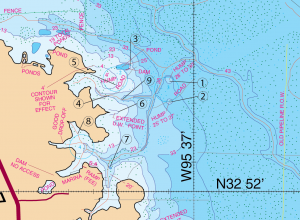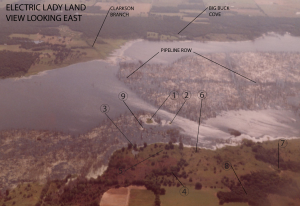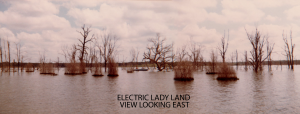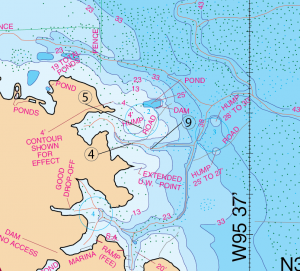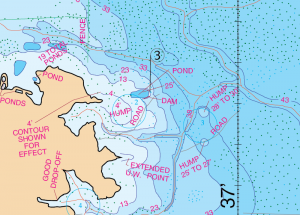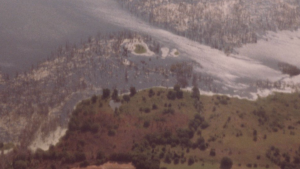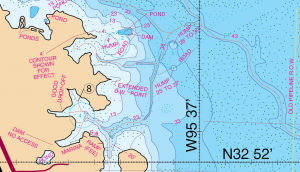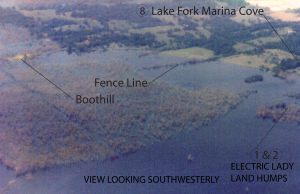The “Gut & The Flat” - Facts and Reasons
Location: #4, #5, & #9
This spot typifies two similar but different feeding patterns. “The Gut” – Notice that the map shows some very apparent clues for you. In this area located north of Lake Fork Marina lies a cove, and to the north lies a large flat. On the very north side of this flat lies a pond (location #3 mentioned in detail later in this article). This location #4 is a slough or what you might call a rather severe gut or ditch (small creek channel). The big deal about all this has to do with the near proximity of this combined slough/flat/pond structure to deep, main lake water. This area has what you would call great “structural value”. Now what that means is that this area has everything a bass needs. The great part about this is that it has very discernible pathways for these bass to use to migrate back and forth on. There is a lot of bait around here so it’s a great food source for them. It has close by spawning areas, cedar tree cover, and other structural features that provide everything a big fish would need. The fish in this area have, through time developed two well learned, and essentially needed patterns.
Discernible Patterns: The two slightly different patterns taking place here have to do with their spawning patterns which are just typical for bass and the other is their very interesting feeding patterns.
Ok, let us begin at the outer edge of the cove at the slough location #9 on the map. Here you have this nice laid back slough, located south of this really nice Electric Lady Land flat, just to the north. The bass feeding pattern in this area is characterized by the fact that these bass migrate from the deep water (location #9), cedar lined, trees along this natural funnel path made by the creek which follows all the way up to the shallow, cove area (location #4). The quick, noticeable, changes in elevation are very significant here. If you look, you can see that the depths along this channel, quickly change from 25 feet to 13 feet to a shallow 4 foot depth up in the cove. So these fish have, for a long period of time (since the mid 1980’s), had a habit of traveling along this funnel/contour/natural route. These fish migrate from their own personal “sanctuaries” along this preferred, developed with time, migration bass “road”. The word “sanctuary” sounds like a big word but all it means is that this is where these fish feel the most comfortable. It’s what a good fitting glove feels like to them. It’s like someone laying back in that recliner at the house, watching movies, and drinking tea and eating Cheetos. They’ve used this route forever and two days. It is where these fish are most secure and where they are the happiest. This is the path from their living room to the mail box. This is where they are usually going to be. Now, here is what to do at this location #4 on the map. Make sure that you are here, right where the old existing road crosses the creek, on top of this location at 5:00 am in the morning. You need to have a soft jerk bait tied on at this spot. If you do this, you have a good chance to catch a double digit fish here. This spot #4, with it’s variety of close water depth variation, can put you in a position to where the the fish tend to roll right up to to you. This existing funnel route naturally feeds these fish right to your location about this time of the morning. This window of time will last just about 30 minutes. At 5:30am the fish in this general vicinity will begin an age old tradition of chasing bait fish up on the large flat(location #5) north of your current location. So, that being said, at about 5:30 you will want to move over to the edge of this large 3 foot deep flat at location #5. You will want to have a white, 3/8 oz chrome tandem blade spinner bait tied on. You will run back and forth between location #5 and the pond (location #3) located on the north side of this flat. These fish will begin to come out of the deep water on the east side of this flat and that is how these bass will start the day off. If you catch it in this pattern, it will be good until the sun starts coming up. When you look to the east shoreline and you start to see pink in the horizon sky you can bet that this pattern is just about to the end of it.
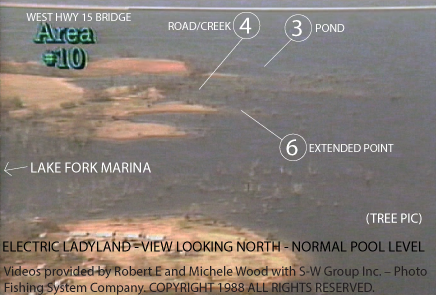
Now, if it’s a really good fishing day, you can turn right around as that suns coming up and never leave that flat if this is the case. What you do is strap on a watermelon colored Carolina rig and throw out in the 12′ deep water. When it’s good there, you can catch a few of the late bass leavers coming off that flat. Doing this can add numbers to your fish catch.
You have some nice size fish that stay in this area. The best reason that I can think of for why these fish were able to grow to such large sizes is that somewhere along the way, in the past, this group of fish found this pattern to be very successful. They learned this and they stuck with what worked. Keep in mind that the larger fish will usually feed in these similar type patterns if they have close access to deeper water as this does. The reason they like feeding in the shallow part of this migration path is that the shallow water is a much easier place for them to isolate their food. In other words it’s easier to dip bait out of a coffee cup than it is to dip it out of the ocean. That flat is like a local convenience store at the end of their street for them. They can go down there, pick up what they want, and they don’t have to stand in line and they don’t have to wait. It’s quick in and quick out. The reason these fish are larger here is that they are the couch potatoes of the fish world when located here. To obtain food is easy for them, and they don’t have to exert a lot of effort in order to get it.
Location: #4
Timing: Be at location #4 at 5:00AM to 5:30 AM -the first week in May, then 5:30am till the Sunlight starts turning the sky pink in the East, then from that time on, December, January, and early to mid February, and July & Mid-August.
What to Do: You will want to be throwing a “Super Fluke” or something similar. Pick your favorite color (the one you feel most comfortable with) and go with it. When selecting those colors bear in mind at that time of day it is usually very dark. The darker the day is the darker the color you want for your bait. The lighter the day is the lighter color of bait you will need to use. Watermelon with a chartreuse tail works for me. Red shad works as well.
Location: #5
“The Flat” – This flat does not have “lay downs”(logs) nor does it have a bunch of stumps. This area has scattered cedar trees, a sandy soil base, and is mostly shallow water. Its vegetation in the past was mostly hydrilla with some scattered coon tails. If it doesn’t have grass you’ll have target fish the available weeds and reeds. It’s a shallow flat that extends out into open the water with no protection from the wind. So just remember that it can get rough here with wind. The wind here can however be your friend in the fact that it will often blow bait fish up on to this flat. You’ll see more south winds here in early May. And historically you’ll find that there is a wind that swirls onto and across the lake upon this flat. So in effect, the great thing here is that you will constantly having bait fish up on to this flat.
Other things to remember about “The Flat” #5 – A couple of other times during the year have shown to be productive as well. A significant temperature to look for is when the water temperature turns 52 degrees. You will observe this temperature in December, January, and early to mid February. When you catch the lake turning to this temperature, be up on “The Flat” itself (location #3). You’ll want to be throwing a red rattletrap. If you catch this area during this time you have a good chance of catching a really nice fish. The time of day is somewhere in the middle of the day, anywhere from mid-morning to mid-afternoon is a good time. Just pull up there and work “The Flat” with a red rattletrap. Go up and down one, two, or three times. This will tell you if there is a good fish up there feeding or not. Normally if you are going to catch a fish during this time it will be a better fish than normal.
Timing: December, January, and early to mid February – when the water temperature turns 52 degrees.
WHAT TO DO: Throw a red rattletrap

